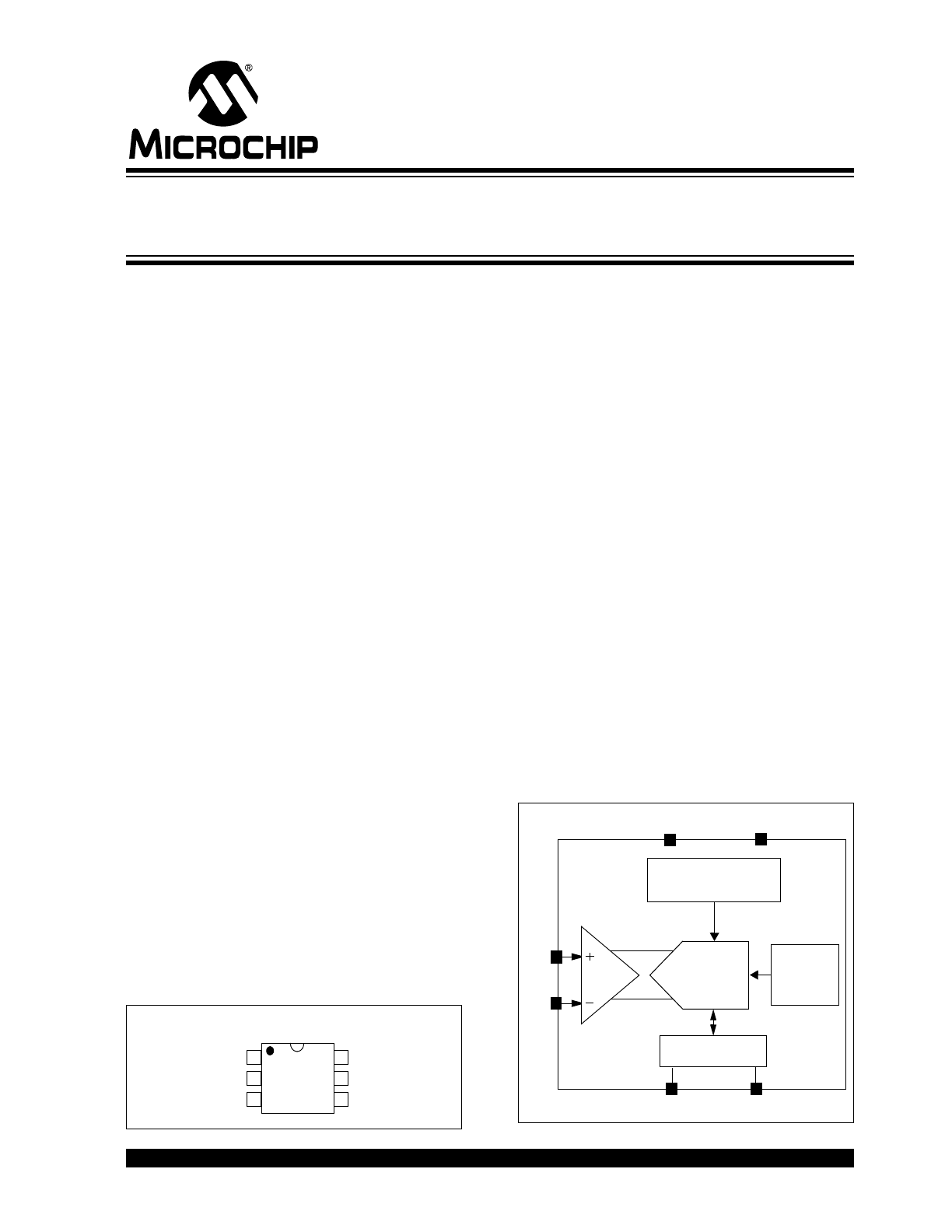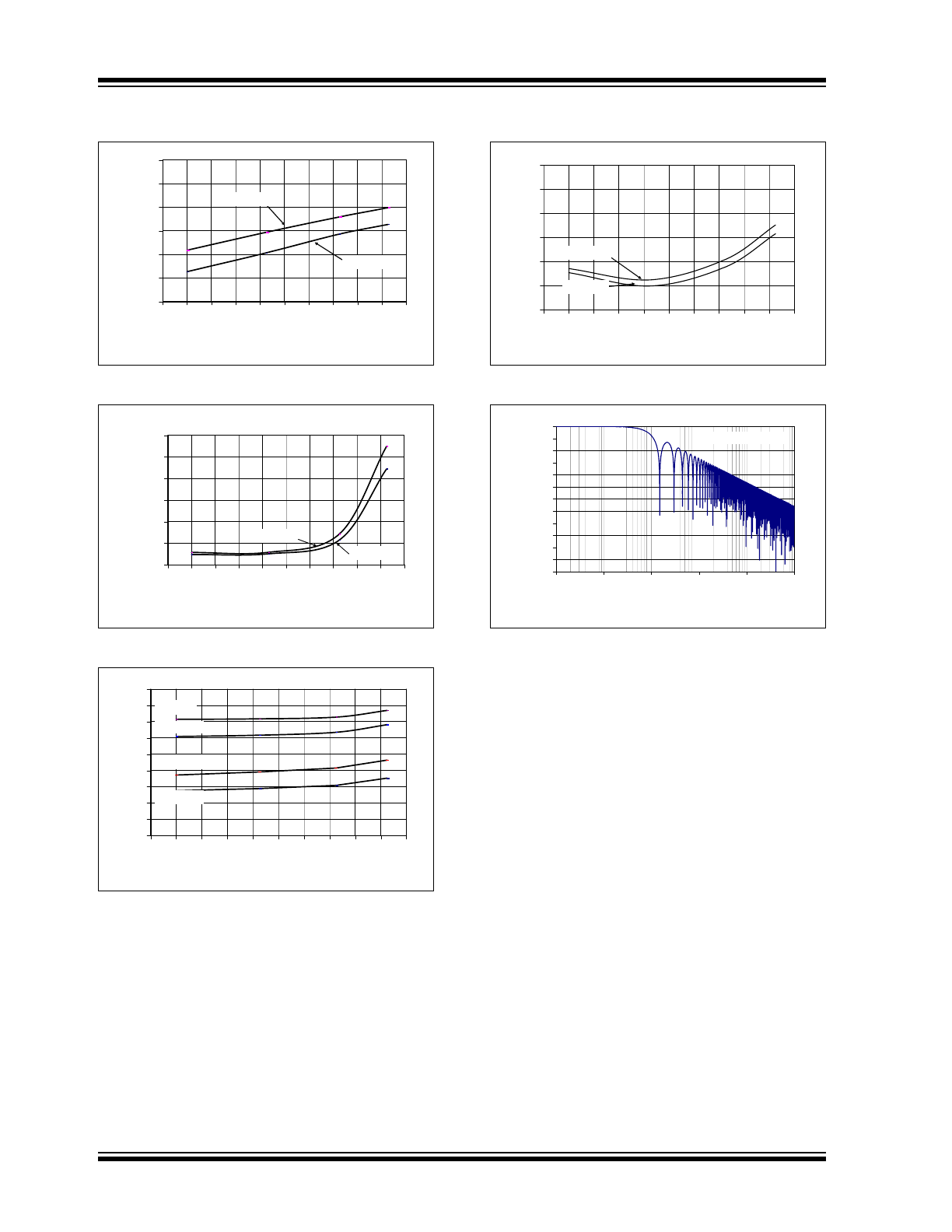
© 2009 Microchip Technology Inc.
DS22072B-page 1
MCP3425
Features
• 16-bit
ΔΣ
ADC in a SOT-23-6 package
• Differential Input Operation
• Self Calibration of Internal Offset and Gain per
each conversion
• On-Board Voltage Reference:
- Accuracy: 2.048V ± 0.05%
• On-Board Programmable Gain Amplifier (PGA):
- Gains of 1, 2, 4 or 8
• On-Board Oscillator
• INL: 10 ppm of FSR (FSR = 4.096V/PGA)
• Programmable Data Rate Options:
- 15 SPS (16 bits)
- 60 SPS (14 bits)
- 240 SPS (12 bits)
• One-Shot or Continuous Conversion Options
• Low Current Consumption:
- 145 µA typical
(V
DD
= 3V, Continuous Conversion)
• One-Shot Conversion (1 SPS) with V
DD
= 3V:
- 9.7 µA typical with 16 bit mode
- 2.4 µA typical with 14 bit mode
- 0.6 µA typical with 12 bit mode
• Supports I
2
C Serial Interface:
- Standard, Fast and High-Speed Modes
• Single Supply Operation: 2.7V to 5.5V
• Extended Temperature Range: -40°C to 125°C
Typical Applications
• Portable Instrumentation
• Weigh Scales and Fuel Gauges
• Temperature Sensing with RTD, Thermistor, and
Thermocouple
• Bridge Sensing for Pressure, Strain, and Force.
Package Types
Description
The MCP3425 is a single channel low-noise, high
accuracy
ΔΣ A/D converter with differential inputs and
up to 16 bits of resolution in a small SOT-23-6 package.
The on-board precision 2.048V reference voltage
enables an input range of ±2.048V differentially
(
Δ voltage = 4.096V). The device uses a two-wire I
2
C
compatible serial interface and operates from a single
2.7V to 5.5V power supply.
The MCP3425 device performs conversion at rates of
15, 60, or 240 samples per second (SPS) depending
on the user controllable configuration bit settings using
the two-wire I
2
C serial interface. This device has an
on-board programmable gain amplifier (PGA). The
user can select the PGA gain of x1, x2, x4, or x8 before
the analog-to-digital conversion takes place. This
allows the MCP3425 device to convert a smaller input
signal with high resolution. The device has two conver-
sion modes: (a) Continuous mode and (b) One-Shot
mode. In One-Shot mode, the device enters a low
current standby mode automatically after one conver-
sion. This reduces current consumption greatly during
idle periods.
The MCP3425 device can be used for various high
accuracy analog-to-digital data conversion applications
where design simplicity, low power, and small footprint
are major considerations.
Block Diagram
1
2
3
4
5
6
V
IN
+
V
SS
SCL
V
IN
-
V
DD
SDA
MCP3425
SOT-23-6
V
SS
V
DD
V
IN
+
V
IN
-
SCL
SDA
Voltage Reference
Clock
(2.048V)
I
2
C Interface
Gain = 1, 2, 4, or 8
V
REF
ΔΣ ADC
Converter
PGA
Oscillator
16-Bit Analog-to-Digital Converter
with I
2
C Interface and On-Board Reference

MCP3425
DS22072B-page 2
© 2009 Microchip Technology Inc.
NOTES:

© 2009 Microchip Technology Inc.
DS22072B-page 3
MCP3425
1.0
ELECTRICAL
CHARACTERISTICS
1.1
Absolute Maximum Ratings†
V
DD
...................................................................................7.0V
All inputs and outputs w.r.t V
SS
............... –0.3V to V
DD
+0.3V
Differential Input Voltage ...................................... |V
DD
- V
SS
|
Output Short Circuit Current ................................ Continuous
Current at Input Pins ....................................................±2 mA
Current at Output and Supply Pins ............................±10 mA
Storage Temperature ....................................-65°C to +150°C
Ambient Temp. with power applied ...............-55°C to +125°C
ESD protection on all pins
................ ≥ 6 kV HBM, ≥ 400V MM
Maximum Junction Temperature (T
J
) . .........................+150°C
†Notice: Stresses above those listed under “Maximum Rat-
ings” may cause permanent damage to the device. This is a
stress rating only and functional operation of the device at
those or any other conditions above those indicated in the
operational listings of this specification is not implied.
Exposure to maximum rating conditions for extended periods
may affect device reliability
.
ELECTRICAL CHARACTERISTICS
Electrical Specifications: Unless otherwise specified, all parameters apply for T
A
= -40°C to +85°C, V
DD
= +5.0V, V
SS
= 0V,
V
IN
+ = V
IN
- = V
REF
/2. All ppm units use 2*V
REF
as full-scale range.
Parameters
Sym
Min
Typ
Max
Units
Conditions
Analog Inputs
Differential Input Range
—
±2.048/PGA
—
V
V
IN
= V
IN
+ - V
IN
-
Common-Mode Voltage Range
(absolute) (Note 1)
V
SS
-0.3
—
V
DD
+0.3
V
Differential Input Impedance
(Note 2)
Z
IND
(f)
—
2.25/PGA
—
M
Ω
During normal mode operation
Common Mode input
Impedance
Z
INC
(f)
—
25
—
M
Ω
PGA = 1, 2, 4, 8
System Performance
Resolution and No Missing
Codes (Note 8)
12
—
—
Bits
DR = 240 SPS
14
—
—
Bits
DR = 60 SPS
16
—
—
Bits
DR = 15 SPS
Data Rate (Note 3)
DR
176
240
328
SPS
S1,S0 = ‘00’, (12 bits mode)
44
60
82
SPS
S1,S0 = ‘01’, (14 bits mode)
11
15
20.5
SPS
S1,S0 = ‘10’, (16 bits mode)
Output Noise
—
2.5
—
µV
RMS
T
A
= +25°C, DR = 15 SPS,
PGA = 1, V
IN
= 0
Integral Nonlinearity (Note 4)
INL
—
10
—
ppm of
FSR
DR = 15 SPS (Note 6)
Internal Reference Voltage
V
REF
—
2.048
—
V
Gain Error (Note 5)
—
0.1
—
%
PGA = 1, DR = 15 SPS
PGA Gain Error Match (Note 5)
—
0.1
—
%
Between any 2 PGA gains
Gain Error Drift (Note 5)
—
15
—
ppm/°C
PGA=1, DR = 15 SPS
Note
1:
Any input voltage below or greater than this voltage causes leakage current through the ESD diodes at the input pins.
This parameter is ensured by characterization and not 100% tested.
2:
This input impedance is due to 3.2 pF internal input sampling capacitor.
3:
The total conversion speed includes auto-calibration of offset and gain.
4:
INL is the difference between the endpoints line and the measured code at the center of the quantization band.
5:
Includes all errors from on-board PGA and V
REF
.
6:
Full Scale Range (FSR) = 2 x 2.048/PGA = 4.096/PGA.
7:
This parameter is ensured by characterization and not 100% tested.
8:
This parameter is ensured by design and not 100% tested.

MCP3425
DS22072B-page 4
© 2009 Microchip Technology Inc.
TEMPERATURE SPECIFICATIONS
Offset Error
V
OS
—
30
—
µV
Tested at PGA = 1
V
DD
= 5.0V and DR = 15 SPS
Offset Drift vs. Temperature
—
300
—
nV/°C
V
DD
= 5.0V
Common-Mode Rejection
—
100
—
dB
at DC and PGA =1,
—
105
—
dB
at DC and PGA =8,
T
A
= +25°C
Gain vs. V
DD
—
5
—
ppm/V
T
A
= +25°C, V
DD
= 2.7V to 5.5V,
PGA = 1
Power Supply Rejection at DC
—
95
—
dB
T
A
= +25°C, V
DD
= 2.7V to 5.5V,
PGA = 1
Power Requirements
Voltage Range
V
DD
2.7
—
5.5
V
Supply Current during
Conversion
I
DDA
—
155
190
µA
V
DD
= 5.0V
—
145
—
µA
V
DD
= 3.0V
Supply Current during Standby
Mode
I
DDS
—
0.1
0.5
µA
I
2
C Digital Inputs and Digital Outputs
High level input voltage
V
IH
0.7 V
DD
—
V
DD
V
Low level input voltage
V
IL
—
—
0.3V
DD
V
Low level output voltage
V
OL
—
—
0.4
V
I
OL
= 3 mA, V
DD
= +5.0V
Hysteresis of Schmitt Trigger
for inputs (Note 7)
V
HYST
0.05V
DD
—
—
V
f
SCL
= 100 kHz
Supply Current when I
2
C bus
line is active
I
DDB
—
—
10
µA
Input Leakage Current
I
ILH
—
—
1
µA
V
IH
= 5.5V
I
ILL
-1
—
—
µA
V
IL
= GND
Pin Capacitance and I
2
C Bus Capacitance
Pin capacitance
C
PIN
—
—
10
pF
I
2
C Bus Capacitance
C
b
—
—
400
pF
Electrical Characteristics: Unless otherwise indicated, T
A
= -40°C to +85°C, V
DD
= +5.0V, V
SS
= 0V.
Parameters
Sym
Min
Typ
Max
Units
Conditions
Temperature Ranges
Specified Temperature Range
TA
-40
—
+85
°C
Operating Temperature Range
T
A
-40
—
+125
°C
Storage Temperature Range
T
A
-65
—
+150
°C
Thermal Package Resistances
Thermal Resistance, 6L SOT-23
θ
JA
—
190.5
—
°C/W
ELECTRICAL CHARACTERISTICS (CONTINUED)
Electrical Specifications: Unless otherwise specified, all parameters apply for T
A
= -40°C to +85°C, V
DD
= +5.0V, V
SS
= 0V,
V
IN
+ = V
IN
- = V
REF
/2. All ppm units use 2*V
REF
as full-scale range.
Parameters
Sym
Min
Typ
Max
Units
Conditions
Note
1:
Any input voltage below or greater than this voltage causes leakage current through the ESD diodes at the input pins.
This parameter is ensured by characterization and not 100% tested.
2:
This input impedance is due to 3.2 pF internal input sampling capacitor.
3:
The total conversion speed includes auto-calibration of offset and gain.
4:
INL is the difference between the endpoints line and the measured code at the center of the quantization band.
5:
Includes all errors from on-board PGA and V
REF
.
6:
Full Scale Range (FSR) = 2 x 2.048/PGA = 4.096/PGA.
7:
This parameter is ensured by characterization and not 100% tested.
8:
This parameter is ensured by design and not 100% tested.

© 2009 Microchip Technology Inc.
DS22072B-page 5
MCP3425
2.0
TYPICAL PERFORMANCE CURVES
Note: Unless otherwise indicated, T
A
= -40°C to +85°C, V
DD
= +5.0V, V
SS
= 0V, V
IN
+ = V
IN
- = V
REF
/2.
FIGURE 2-1:
INL vs. Supply Voltage
(V
DD
).
FIGURE 2-2:
INL vs. Temperature.
FIGURE 2-3:
Offset Error vs.
Temperature.
FIGURE 2-4:
Output Noise vs. Input
Voltage.
FIGURE 2-5:
Total Error vs. Input Voltage.
FIGURE 2-6:
Gain Error vs. Temperature.
Note:
The graphs and tables provided following this note are a statistical summary based on a limited number of
samples and are provided for informational purposes only. The performance characteristics listed herein
are not tested or guaranteed. In some graphs or tables, the data presented may be outside the specified
operating range (e.g., outside specified power supply range) and therefore outside the warranted range.
0
0.001
0.002
0.003
0.004
0.005
2.5
3
3.5
4
4.5
5
5.5
V
DD
(V)
Integra
l Nonlinea
rity
(% FS
R)
PGA = 1
PGA = 4
PGA = 8
PGA = 2
0
0.001
0.002
0.003
0.004
0.005
-60 -40 -20
0
20
40
60
80 100 120 140
Temperature (
o
C)
INL (FS
R
%)
2.7V
5V
-60
-40
-20
0
20
40
60
-60 -40 -20
0
20
40
60
80 100 120 140
Temperature (°C )
Off
s
et Error (µV)
PGA = 1
PGA = 8
PGA = 4
PGA = 2
0
2
4
6
8
10
12
-100%
-50%
0%
50%
100%
Input Voltage (% of Full Scale)
Nois
e (
µ
V
, rms)
PGA = 1
PGA = 8
PGA = 4
PGA = 2
-3.0
-2.0
-1.0
0.0
1.0
2.0
3.0
-100
-75
-50
-25
0
25
50
75
100
Input Voltage (% of Full Scale)
T
o
ta
l E
rro
r
(m
V
)
PGA = 1
PGA = 2
PGA = 8
PGA = 4
-0.4
-0.3
-0.2
-0.1
0
0.1
0.2
0.3
0.4
-60 -40 -20
0
20
40
60
80 100 120 140
Temperature (°C)
Gain
Err
o
r (% o
f FSR
)
V
DD
= 5.0V
PGA = 1
PGA = 2
PGA = 8
PGA = 4

MCP3425
DS22072B-page 6
© 2009 Microchip Technology Inc.
Note: Unless otherwise indicated, T
A
= -40°C to +85°C, V
DD
= +5.0V, V
SS
= 0V, V
IN
+ = V
IN
- = V
REF
/2.
FIGURE 2-7:
I
DDA
vs. Temperature.
FIGURE 2-8:
I
DDS
vs. Temperature.
FIGURE 2-9:
I
DDB
vs. Temperature.
FIGURE 2-10:
OSC Drift vs. Temperature.
FIGURE 2-11:
Frequency Response.
100
120
140
160
180
200
220
-60 -40 -20
0
20
40
60
80 100 120 140
Temperature (
o
C)
I
DD
A
(µ
A
)
V
DD
= 5V
V
DD
= 2.7V
0
100
200
300
400
500
600
-60 -40 -20
0
20
40
60
80 100 120 140
Temperature (
o
C)
I
DD
S
(n
A)
V
DD
= 2.7V
V
DD
= 5V
0
1
2
3
4
5
6
7
8
9
-60 -40 -20
0
20
40
60
80 100 120 140
Temperature (
o
C)
I
DDB
(µ
A
)
V
DD
= 5V
V
DD
= 4.5V
V
DD
= 3.3V
V
DD
= 2.7V
-1
0
1
2
3
4
5
-60 -40 -20
0
20
40
60
80
100 120 140
Temperature (°C)
O
sci
ll
at
o
r D
rif
t
(%
)
V
DD
= 5.0V
V
DD
= 2.7V
-120
-110
-100
-90
-80
-70
-60
-50
-40
-30
-20
-10
0
0.1
1
10
100
1000
10000
Input Signal Frequency (Hz)
M
a
gnit
u
d
e
(dB)
Data Rate = 15 SPS
10k
1k

© 2009 Microchip Technology Inc.
DS22072B-page 7
MCP3425
3.0
PIN DESCRIPTIONS
The descriptions of the pins are listed in
Table 3-1
.
TABLE 3-1:
PIN FUNCTION TABLE
3.1
Analog Inputs (V
IN
+, V
IN
-)
V
IN
+ and V
IN
- are differential signal input pins. The
MCP3425 device accepts a fully differential analog
input signal which is connected on the V
IN
+ and V
IN
-
input pins. The differential voltage that is converted is
defined by V
IN
= (V
IN
+ - V
IN
-) where V
IN
+ is the voltage
applied at the V
IN
+ pin and V
IN
- is the voltage applied
at the V
IN
- pin. The input signal level is amplified by the
programmable gain amplifier (PGA) before the
conversion. The differential input voltage should not
exceed an absolute of (V
REF
/PGA) for accurate
measurement, where V
REF
is the internal reference
voltage (2.048V) and PGA is the PGA gain setting. The
converter output code will saturate if the input range
exceeds (V
REF
/PGA).
The absolute voltage range on each of the differential
input pins is from V
SS
-0.3V to V
DD
+0.3V. Any voltage
above or below this range will cause leakage currents
through the Electrostatic Discharge (ESD) diodes at
the input pins. This ESD current can cause unexpected
performance of the device. The common mode of the
analog inputs should be chosen such that both the
differential analog input range and the absolute voltage
range on each pin are within the specified operating
range defined in Section 1.0 “Electrical
Characteristics” and Section 4.0 “Description of
Device Operation”.
3.2
Supply Voltage (V
DD
, V
SS
)
V
DD
is the power supply pin for the device. This pin
requires an appropriate bypass capacitor of about
0.1 µF (ceramic) to ground. An additional 10 µF
capacitor (tantalum) in parallel is also recommended
to further attenuate high frequency noise present in
some application boards. The supply voltage (V
DD
)
must be maintained in the 2.7V to 5.5V range for
specified operation.
V
SS
is the ground pin and the current return path of the
device. The user must connect the V
SS
pin to a ground
plane through a low impedance connection. If an
analog ground path is available in the application PCB
(printed circuit board), it is highly recommended that
the V
SS
pin be tied to the analog ground path or
isolated within an analog ground plane of the circuit
board.
3.3
Serial Clock Pin (SCL)
SCL is the serial clock pin of the I
2
C interface. The
MCP3425 acts only as a slave and the SCL pin
accepts only external serial clocks. The input data
from the Master device is shifted into the SDA pin on
the rising edges of the SCL clock and output from the
MCP3425 occurs at the falling edges of the SCL clock.
The SCL pin is an open-drain N-channel driver.
Therefore, it needs a pull-up resistor from the V
DD
line
to the SCL pin. Refer to Section 5.3 “I
2
C Serial Com-
munications” for more details of I
2
C Serial Interface
communication.
3.4
Serial Data Pin (SDA)
SDA is the serial data pin of the I
2
C interface. The SDA
pin is used for input and output data. In read mode, the
conversion result is read from the SDA pin (output). In
write mode, the device configuration bits are written
(input) though the SDA pin. The SDA pin is an open-
drain N-channel driver. Therefore, it needs a pull-up
resistor from the V
DD
line to the SDA pin. Except for
start and stop conditions, the data on the SDA pin must
be stable during the high period of the clock. The high
or low state of the SDA pin can only change when the
clock signal on the SCL pin is low. Refer to Section 5.3
“I
2
C Serial Communications” for more details of I
2
C
Serial Interface communication.
MCP3425
Symbol
Definition
SOT-23-6
1
V
IN
+
Positive Differential Analog Input Pin
2
V
SS
Ground Pin
3
SCL
Serial Clock Input Pin of the I
2
C Interface
4
SDA
Bidirectional Serial Data Pin of the I
2
C Interface
5
V
DD
Positive Supply Voltage Pin
6
V
IN
-
Negative Differential Analog Input Pin

MCP3425
DS22072B-page 8
© 2009 Microchip Technology Inc.
NOTES:

© 2009 Microchip Technology Inc.
DS22072B-page 9
MCP3425
4.0
DESCRIPTION OF DEVICE
OPERATION
4.1
General Overview
The MCP3425 is a low-power, 16-Bit Delta-Sigma A/D
converter with an I
2
C serial interface. The device
contains an on-board voltage reference (2.048V),
programmable gain amplifier (PGA), and internal
oscillator. The user can select 12, 14, or 16 bit
conversion by setting the configuration register bits.
The device can be operated in Continuous Conversion
or One-Shot Conversion mode. In the Continuous
Conversion mode, the device converts the inputs
continuously. While in the One-Shot Conversion mode,
the device converts the input one time and stays in the
low-power standby mode until it receives another
command for a new conversion. During the standby
mode, the device consumes less than 0.1 µA typical.
When the device powers up (POR is set), it
automatically resets the configuration bits to default
settings.
Device default settings are:
• Conversion bit resolution: 12 bits (240 sps)
• PGA gain setting: x1
• Continuous conversion
Once the device is powered-up, the user can
reprogram the configuration bits using I
2
C serial
interface any time. The configuration bits are stored in
volatile memory.
User selectable options are:
• Conversion bit resolution: 12, 14, or 16 bits
• PGA Gain selection: x1, x2, x4, or x8
• Continuous or one-shot conversion
In the Continuous Conversion mode, the device
converts the inputs continuously. While in the One-Shot
Conversion mode, the device converts the input one
time and stays in the low-power standby mode until it
receives another command for a new conversion.
During the standby mode, the device consumes less
than 1 µA maximum.
4.2
Power-On-Reset (POR)
The device contains an internal Power-On-Reset
(POR) circuit that monitors power supply voltage (V
DD
)
during operation. This circuit ensures correct device
start-up at system power-up and power-down events.
The POR has built-in hysteresis and a timer to give a
high degree of immunity to potential ripples and noises
on the power supply. A 0.1 µF decoupling capacitor
should be mounted as close as possible to the V
DD
pin
for additional transient immunity.
The threshold voltage is set at 2.2V with a tolerance of
approximately ±5%. If the supply voltage falls below
this threshold, the device will be held in a reset
condition. The typical hysteresis value is approximately
200 mV.
The POR circuit is shut-down during the low-power
standby mode. Once a power-up event has occurred,
the device requires additional delay time
(approximately 300 µs) before a conversion can take
place. During this time, all internal analog circuitries are
settled before the first conversion occurs.
Figure 4-1
illustrates the conditions for power-up and power-down
events under typical start-up conditions.
When the device powers up, it automatically resets
and sets the configuration bits to default settings. The
default configuration bit conditions are a PGA gain of
1 V/V and a conversion speed of 240 SPS in
Continuous Conversion mode. When the device
receives an I
2
C General Call Reset command, it
performs an internal reset similar to a Power-On-Reset
event.
FIGURE 4-1:
POR Operation.
4.3
Internal Voltage Reference
The device contains an on-board 2.048V voltage
reference. This reference voltage is for internal use
only and not directly measurable. The specifications of
the reference voltage are part of the device’s gain and
drift specifications. Therefore, there is no separate
specification for the on-board reference.
4.4
Analog Input Channel
The differential analog input channel has a switched
capacitor structure. The internal sampling capacitor
(3.2 pF for PGA = 1) is charged and discharged to
process a conversion. The charging and discharging of
the input sampling capacitor creates dynamic input
currents at each input pin. The current is a function of
the differential input voltages, and inversely
proportional to the internal sampling capacitance,
sampling frequency, and PGA setting.
V
DD
2.2V
2.0V
300 µS
Reset Start-up
Normal Operation
Reset
Time

MCP3425
DS22072B-page 10
© 2009 Microchip Technology Inc.
4.5
Input Voltage Range
The differential (V
IN
) and common mode voltage
(V
INCOM
) at the input pins without considering PGA
setting are defined by:
The input signal levels are amplified by the internal
programmable gain amplifier (PGA) at the front end of
the
ΔΣ modulator.
The user needs to consider two conditions for the input
voltage range: (a) Differential input voltage range and
(b) Absolute maximum input voltage range.
4.5.1
DIFFERENTIAL INPUT VOLTAGE
RANGE
The device performs conversions using its internal
reference voltage (V
REF
= 2.048V). Therefore, the
absolute value of the differential input voltage (V
IN
),
with PGA setting is included, needs to be less than the
internal reference voltage. The device will output
saturated output codes (all 0s or all 1s except sign bit)
if the absolute value of the input voltage (V
IN
), with
PGA setting is included, is greater than the internal
reference voltage (V
REF
= 2.048V). The input full-scale
voltage range is given by:
EQUATION 4-1:
If the input voltage level is greater than the above limit,
the user can use a voltage divider and bring down the
input level within the full-scale range. See
Figure 6-7
for more details of the input voltage divider circuit.
4.5.2
ABSOLUTE MAXIMUM INPUT
VOLTAGE RANGE
The input voltage at each input pin must be less than
the following absolute maximum input voltage limits:
• Input voltage < V
DD
+0.3V
• Input voltage > V
SS
-0.3V
Any input voltage outside this range can turn on the
input ESD protection diodes, and result in input
leakage current, causing conversion errors, or
permanently damage the device.
Care must be taken in setting the input voltage ranges
so that the input voltage does not exceed the absolute
maximum input voltage range.
4.6
Input Impedance
The device uses a switched-capacitor input stage using
a 3.2 pF sampling capacitor. This capacitor is switched
(charged and discharged) at a rate of the sampling
frequency that is generated by on-board clock. The
differential input impedance varies with the PGA
settings. The typical differential input impedance during
a normal mode operation is given by:
Since the sampling capacitor is only switching to the
input pins during a conversion process, the above input
impedance is only valid during conversion periods. In a
low power standby mode, the above impedance is not
presented at the input pins. Therefore, only a leakage
current due to ESD diode is presented at the input pins.
The conversion accuracy can be affected by the input
signal source impedance when any external circuit is
connected to the input pins. The source impedance
adds to the internal impedance and directly affects the
time required to charge the internal sampling capacitor.
Therefore, a large input source impedance connected
to the input pins can degrade the system performance,
such as offset, gain, and Integral Non-Linearity (INL)
errors. Ideally, the input source impedance should be
zero. This can be achievable by using an operational
amplifier with a closed-loop output impedance of tens
of ohms.
4.7
Aliasing and Anti-aliasing Filter
Aliasing occurs when the input signal contains
time-varying signal components with frequency greater
than half the sample rate. In the aliasing conditions, the
device can output unexpected output codes. For
applications that are operating in electrical noise
environments, the time-varying signal noise or high
frequency interference components can be easily
added to the input signals and cause aliasing. Although
the device has an internal first order sinc filter, the filter
response (
Figure 2-11
) may not give enough
attenuation to all aliasing signal components. To avoid
the aliasing, an external anti-aliasing filter, which can
be accomplished with a simple RC low-pass filter, is
typically used at the input pins. The low-pass filter cuts
off the high frequency noise components and provides
a band-limited input signal to the input pins.
4.8
Self-Calibration
The device performs a self-calibration of offset and
gain for each conversion. This provides reliable
conversion results from conversion-to-conversion over
variations in temperature as well as power supply
fluctuations.
V
IN
V
IN
+
V
IN
-
–
=
V
INCOM
V
IN
+
V
IN
-
+
2
-------------------------------
=
Where:
V
IN
=
V
IN
+ - V
IN
-
V
REF
=
2.048V
V
REF
–
V
IN
PGA
•
(
)
V
REF
1LSB
–
(
)
≤
≤
Z
IN
(f) = 2.25 M
Ω
/PGA
